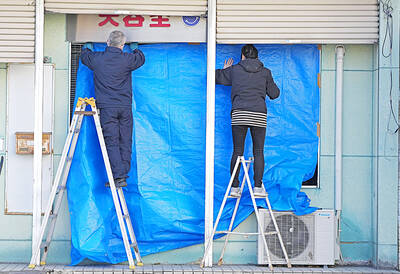The National Health Research Institute sent an alarming message yesterday to the nation's betel-nut chewers: If they also smoke and drink, they are 195 times more likely to contract cancer of the esophagus than those who do not. They are also 96.9 times more likely to get cancer of the pharynx and 40.3 times more likely to contract cancer of the larynx.
Those statistics are based on a study conducted by a group of health researchers, headed by Ko Ying-chin (
Ko said at a presentation in Taipei yesterday that this shows chewing betel nuts has a detrimental effect on the overall metabolic system.
"Before, we only knew that chewing betel nuts could lead to oral cancer and other oral-related diseases," Ko said, "but now we have found that it can also harm other parts of the body."
Ko said that betel nuts have been identified by academics and researchers as a first-class cancer-causing substance. Even though betel-nut chewers spit out the juice, some of it is swallowed and goes into the bloodstream. Arecoline, an ingredient in the betel nut, becomes the residue that stays in the organs.
The study also studied the effect of betel nuts on pregnant women. It sampled 1,608 women from hospitals in southern and eastern Taiwan. The results showed that 14.72 percent of women who were habitual betel-nut chewers gave birth to underweight infants, versus 8.24 percent of those who were non-betel nut chewers.
On average, infants whose mothers chewed betel nuts during pregnancy weighed 3.0kg, while those whose mothers did not chew betel nuts weighed 3.1kg.
Pregnant women who chewed betel nuts were 2.8 times more likely to experience still births, miscarriages or have premature babies.
Yang Mei-sang (楊美賞), professor and dean of the college of nursing at Kaohsiung Medical College, said that a direct relationship has been established between a female's educational level and betel-nut chewing habit. Less educated females are more likely to become betel nut chewers, she said.
Yang also cited research results from other international medical journals to illustrate the potential effects of betel nuts. The study among Southeast Asian immigrants in Europe, for example, found that infants of betel-nut chewing mothers suffered from neonatal abstinence syndrome. It normally occurs among mothers taking addictive substance during pregnancy.
The institute's statistics also indicated that about 70,000 cancer cases are detected in the country each year, with 6 percent to 8 percent involving betel-nut chewers.
Oral cancer has been identified as one of the most common forms of cancer among males in the country, with a high incidence rate of 30 out of 100,000. Males who have oral cancer die, on average, at the age of 53 -- 10 years earlier than those who die from other forms of cancer.
The study also found that Aborigines account for a larger percentage of the betel-nut chewing population. Of the 10 percent of betel-nut chewers in Taiwan, 40 percent were Aborigines.
After India, Taiwan is the world's second-largest producer of betel nuts. Production increased from 3,718 tonnes in 1961 to 165,076 tonnes in 2001.
Ko estimated that the government has to spend at least NT$5 billion (US$151 million) a year to cover medical expenses for betel nut-related diseases.

Taiwanese were praised for their composure after a video filmed by Taiwanese tourists capturing the moment a magnitude 7.5 earthquake struck Japan’s Aomori Prefecture went viral on social media. The video shows a hotel room shaking violently amid Monday’s quake, with objects falling to the ground. Two Taiwanese began filming with their mobile phones, while two others held the sides of a TV to prevent it from falling. When the shaking stopped, the pair calmly took down the TV and laid it flat on a tatami mat, the video shows. The video also captured the group talking about the safety of their companions bathing

US climber Alex Honnold is to attempt to scale Taipei 101 without a rope and harness in a live Netflix special on Jan. 24, the streaming platform announced on Wednesday. Accounting for the time difference, the two-hour broadcast of Honnold’s climb, called Skyscraper Live, is to air on Jan. 23 in the US, Netflix said in a statement. Honnold, 40, was the first person ever to free solo climb the 900m El Capitan rock formation in Yosemite National Park — a feat that was recorded and later made into the 2018 documentary film Free Solo. Netflix previewed Skyscraper Live in October, after videos

Starting on Jan. 1, YouBike riders must have insurance to use the service, and a six-month trial of NT$5 coupons under certain conditions would be implemented to balance bike shortages, a joint statement from transportation departments across Taipei, New Taipei City and Taoyuan announced yesterday. The rental bike system operator said that coupons would be offered to riders to rent bikes from full stations, for riders who take out an electric-assisted bike from a full station, and for riders who return a bike to an empty station. All riders with YouBike accounts are automatically eligible for the program, and each membership account

A classified Pentagon-produced, multiyear assessment — the Overmatch brief — highlighted unreported Chinese capabilities to destroy US military assets and identified US supply chain choke points, painting a disturbing picture of waning US military might, a New York Times editorial published on Monday said. US Secretary of Defense Pete Hegseth’s comments in November last year that “we lose every time” in Pentagon-conducted war games pitting the US against China further highlighted the uncertainty about the US’ capability to intervene in the event of a Chinese invasion of Taiwan. “It shows the Pentagon’s overreliance on expensive, vulnerable weapons as adversaries field cheap, technologically